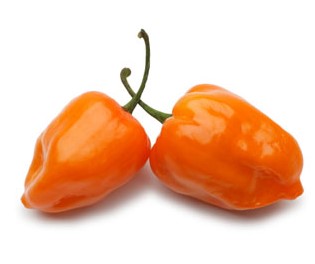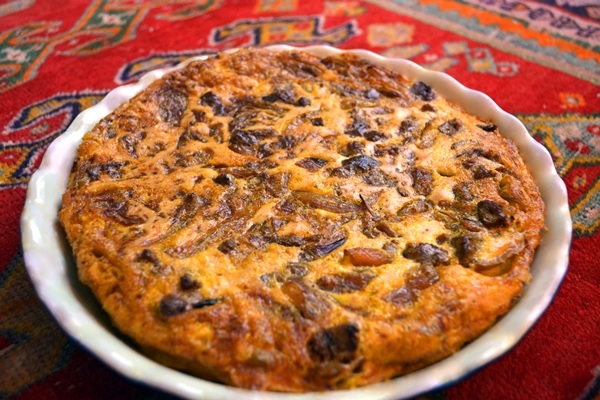Described by the Spanish in 1492 during the first Columbian voyage to the New World, chili peppers took the Old World by storm. Brought by the Portuguese to their colonies in Africa and India by the end of the 15th Century, chilies were so eagerly adopted by the indigenous peoples of these regions that they became widespread naturalized crops within a couple of decades.

Interestingly, the adoption of chilies within Europe itself was somewhat slower, with the first real scientific description being made in the 1540s by Fuchs, and the earliest published recipes only appearing in the 17th Century.
While I was working with the early East Indian curry recipe in Domingos Rodrigues’ Arte de Cozhina (1680), I stumbled upon some of these early European chili recipes. Although I am still translating and developing these recipes, I found a real gem of a dish that I’d like to share with you: a delicious 17th Century Portuguese “frittata” with lamb and spices that also packs a wallop of heat because of the chilies it contains.
____
The original recipe reads:
Pasteis de perna de Carneiro
Metase em uma panela uno perna de Carneiro, meyo arratel de toucinho, duas onças de manteiga, duas cebolas, um golpe de vinagre, adubos inteiro, e uma capelle de todos os cheiro, e pan-se a cozer em agua pouca ; estando jà o Carneiro mais de meyo cozido, tirese fóra, e piquese a parte todo o Carneiro ; e logo em outra parte piquemse os cheiro, e em uma tigela baixa, untada de manteiga se vàpondo cama de Carneiro, cama de toucinho : deitemse logo por cima meya duzia de ovos batidos, e pan-se a córar em lume brando.
Feito isto, façable de fóra parte umas sopas da dita substancia, e depois que estiverem muy aboboradas, virese a tigella, em que se fizerem, sobre o prato, equebrese a tigela, para que a sopa fique inteira ; sobre ella se porà o pastel, e lançindolhe por cima çumo de limaõ, mandesa à mesa.
Tambem se faz de lombos, e vitela, ou da carne que quizerem.
_____
My liberal and functional translation of this is:
Frittata with Lamb
Place a leg of lamb in a pan with the lard from one pound of bacon, two ounces of butter, two onions, a stroke of vinegar, and whole spices. Separately, place the chili peppers to cook in a little water.
When most of the fat has evaporated, take the lamb from the pan and remove the meat from the bone. Chop up the hot peppers and mix them with the meat.
In a shallow bowl, greased with butter, place the chopped lamb [and peppers]. Above this lay down a double layer of bacon. Pour a dozen beaten eggs over this and place in the oven until golden brown but still soft.
This done, now it is time to turn the eggs out of the pan. Place flatbread on top of the pan and cover this with a plate. Turn the pan with the eggs over so that the eggs come out in one piece. Pour lemon juice over the dish and send it to the table.
Also can be made with veal or beef tenderloin.
Written in modern form, the recipe looks like this:
Lamb Frittata with Chili Peppers
Ingredients
2 pounds of lamb cut from the leg, trimmed into bite-size pieces
fat from 1 pound of bacon
4 tablespoons sweet butter, plus a bit more to grease the pie dish
2 tablespoons cumin seeds
2 tablespoons caraway seeds
1.5 tablespoons coriander seeds
1/4 teaspoon cayenne (optional)
1 teaspoon ground turmeric
1 large onion, peeled and sliced
1-2 tablespoons malt vinegar
3-4 dried Habanero peppers (more or less to taste)
6 eggs, whisked until frothy
juice of half a lemon
chopped cilantro for garnish
Directions
Dry roast or pan fry the whole spices until lightly colored and set aside to cool. Crack or coarsely grind the roasted spices. Melt the bacon fat and butter over high heat in a large sauté pan and add the lamb, stirring often as the meat colors and cooks. When the lamb starts to brown, remove it from the pan and set aside.
Lower the heat to medium and add the roasted spices. Add the cayenne (if using) and the turmeric, and stir well. Add the sliced onion, stir, lower heat again, and cover to cook for 5-8 minutes. Add the malt vinegar, stir well, and add the lamb back into the pan. Mix well and allow the lamb to cook over medium or medium-low heat for 15-20 minutes until it starts to become tender.
Heat some water to boil in a small sauté pan. Remove from heat and drop the chili peppers into the hot water. Let chilies soak for a minute or two and remove from the pan to drain. Mince chilies, but do not remove the seeds or placenta. Habaneros are powerful little gems and you may wish to wear gloves to handle them. When done, wash hands well with soap and water. Add the chilies to the lamb and onion mixture and mix well. When the lamb is tender, remove from the heat.
Preheat oven to 350° F. Grease a deep-dish pie pan with butter (I used a ceramic pan) and add the lamb and onion mixture. Add the frothed eggs and make sure the eggs envelop the lamb. When oven is hot, place the egg pan into the oven and bake for about 8-10 minutes or until the eggs are firm and colored golden-brown. Remove pan from oven and rest for a few minutes.
Run a knife gently around the edge of the pan to loosen the eggs and place an 8-10-inch piece of flatbread (I used commercial, Indian naan) on top of the eggs. Place a serving plate on top of the flatbread and invert to remove the eggs from the pan. Sprinkle lemon juice over the eggs, garnish with cilantro and serve. Serve with slices of lemon on the table for diners to add if desired.
_____
The dish itself is more like an Apician patella or an Iranian kuku than like any other modern dish called a “pasteis” which range from codfish cakes to egg-custard desserts, so I feel that it is acceptable to call it a frittata.
About the chilies. The peppers in the recipe are called pimento de cheiro, or aromatic chilies, which Rodrigues abbreviates to chieros. The genus and species that this represents is Capiscum chinense. Generally speaking as a family, these chilies are known as the Chinese lantern chilies and they are the hottest chilies in the world. Varieties include, the Bhut Jolokia, the Hainan Yellow Lantern, the now infamous Trinidad Scorpion, and the easy to find Habenero chili. For this recipe I used the Habanero, for the ease in acquisition, the ability to control the heat in the recipe, and the assumption that chili peppers in the 17th Century were generally more like the Habanero and less like the Trinidad Scorpion with its 2.5 million Scovilles of heat.
As to how I dealt with the “whole spices” direction? This time I didn’t do original research as I did with the curry spices, I started by using a recipe from a modern edition of Arte de Cozhina that includes a few developed recipes that I found on the internet. It looked like an interesting spice mix, but it unfortunately had no context on how or why the spices were chosen. Nevertheless, I tried it, and it was delicious.
I adapted the recipe a bit by chopping the lamb off the bone before cooking, by reducing the number of eggs by half, and by omitting the bacon, because, although I like the flavor, I often find it overpowering. Even with the adaptations, this is still a rich and savory historical dish that may surprise your family and friends with its unusual combinations of flavors. These choices made may result in a spicier dish than the original, because the meat is taken off the bone before it is sautéed, but it really is quite good this way. I was a bit suspicious about the use of lemon juice on the eggs, but in the end, I found that it worked wonderfully.
There are several other recipes in Arte de Cozhina using different types of chili peppers, if those yield dishes as savory and delicious as this one, I will be sure to let you know. Till then, tuck into this great recipe and imagine what might have been like to be a Portuguese sailor or trader in the in the 17th Century . . . experiencing strange and wonderful foreign cultures along the remnants of the Maritime Silk Road. (Words, recipe translation and development by Laura Kelley, Photo of Habanero Chili Peppers from Wikimedia, and Photo of the Lamb Frittata with Chili Peppers by Laura Kelley).

